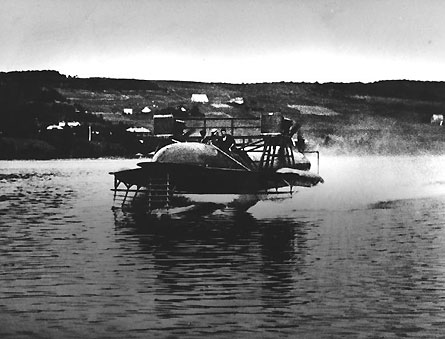I posted this because a few people showed some interest in it when I posted about Bell's hydrofoil in my Thursday's thirteen.

Alexander Graham Bell considered the invention of the hydroplane as a very significant achievement. Based on information gained from that article he began to sketch concepts of what is now called a hydrofoil boat.
Bell and assistant Frederick W. "Casey" Baldwin began hydrofoil experimentation in the summer of 1908 as a possible aid to airplane takeoff from water. Baldwin studied the work of the Italian inventor Enrico Forlanini and began testing models. This led him and Bell to the development of practical hydrofoil watercraft.During his world tour of 1910–11, Bell and Baldwin met with Forlanini in France. They had rides in the Forlanini hydrofoil boat over Lake Maggiore. Baldwin described it as being as smooth as flying.
On returning to Baddeck, a number of initial concepts were built as experimental models, including the Dhonnas Beag, the first self-propelled Bell-Baldwin hydrofoil.[106] The experimental boats were essentially proof-of-concept prototypes that culminated in the more substantial HD-4, powered by Renault engines. A top speed of 54 miles per hour (87 km/h) was achieved, with the hydrofoil exhibiting rapid acceleration, good stability and steering along with the ability to take waves without difficulty.[107] In 1913, Dr. Bell hired Walter Pinaud, a Sydney yacht designer and builder as well as the proprietor of Pinaud's Yacht Yard in Westmount, Nova Scotia to work on the pontoons of the HD-4. Pinaud soon took over the boatyard at Bell Laboratories on Beinn Bhreagh, Bell's estate near Baddeck, Nova Scotia.
Pinaud's experience in boat-building enabled him to make useful design changes to the HD-4. After the First World War, work began again on the HD-4. Bell's report to the U.S. Navy permitted him to obtain two 350 horsepower (260 kW) engines in July 1919. On September 9, 1919, the HD-4 set a world marine speed record of 70.86 miles per hour (114.04 km/h),[108] a record which stood for ten years.

2 comments:
interesting article :), i would like to see more similar about old inventions :)
Hi Nords,
I think a lot of them did something unusual.
Janice~
Post a Comment